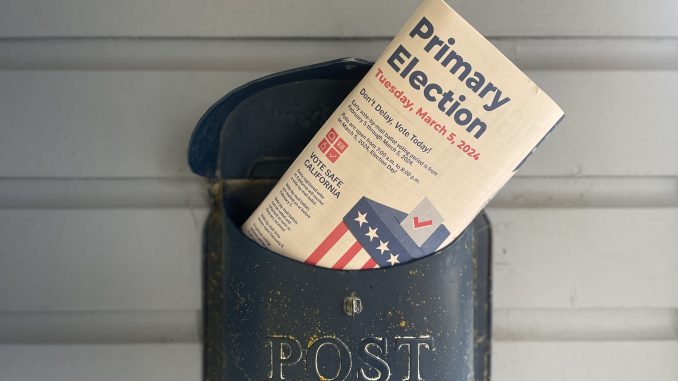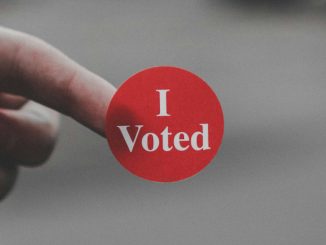
This feature is part of the CN&R’s 2024 election coverage.
This story was produced by CalMatters, an independent public journalism venture covering California state politics and government. (Butte County-specific reporting by Chico News & Review.) For additional CalMatters Primary Election coverage, visit calmatters.org/california-voter-guide-2024.
It’s a presidential election year, so that means California’s primary election is on “Super Tuesday” in March instead of June. But unless something dramatic befalls one of the frontrunners—former President Donald Trump and President Biden—that isn’t likely to be the most talked-about race in California leading up to March 5.
There’s also no real drama in most of the contests for state and federal representation for Butte County. All of the candidates in our state races—David Fennell and Megan Dahle for State Senate District 1 and James Gallagher and Aaron Wade Draper for State Assembly District 3—will move on to the General Election, and incumbent Doug LaMalfa is facing very little challenge from two fatally underfunded Democrats for the District 1 U.S. House seat.
Instead, the focus is on the U.S. Senate race. The seat was filled by Dianne Feinstein from 1993 until her death last September. Then Sen. Laphonza Butler, the temporary replacement appointed by Newsom, shocked the political world by not trying to keep the job. Three big-name Democrats—U.S. Reps. Barbara Lee, Katie Porter and Adam Schiff—are running, as are Republicans Eric Early and Steve Garvey, though Garvey is known in sports, not politics. You can vote for any candidate of any party. The top two finishers, no matter their party, move on to the Nov. 5 general election.
And as Gov. Gavin Newsom wanted, there’s only one statewide ballot measure. If voters say “yes” to Proposition 1, the state can borrow $6.4 billion to pay for 10,000 new mental health treatment beds and overhaul California’s 20-year-old law that funds mental health services with a tax on millionaires.
Read more on Prop 1 below, and for the Senate race click on the following link to find out “Where do five major candidates for U.S. senator stand on the economy, crime and the border?”
What would Proposition 1 do?
This two-pronged measure would fund a $6.4 billion bond to drastically expand the state’s mental health and substance abuse treatment infrastructure. A majority of the money, $4.4 billion, would be used to build 10,000 in-patient and residential treatment beds across the state. The remainder would fund permanent supportive housing with half set aside for veterans with mental illness or addiction disorders.
The second part of the measure would require counties to change the way they spend existing mental health dollars by directing them to prioritize housing for people who are chronically homeless.
Why is it on the ballot?
California faces a shortage of nearly 8,000 adult psychiatric beds, according to research from the RAND Corp. The shortage spans the spectrum of care from acute crisis stabilization beds to long-term sub-acute and community residential services beds. At the same time, demand for youth and adult mental health services and emergency department discharge to psychiatric care are at an all-time high.
The state has also been unable to reverse course on a growing homelessness crisis. More than 170,000 Californians are unhoused, the majority of whom live unsheltered on the streets. Mental health and addiction disorders are highly prevalent among homeless Californians—82 percent and 65 percent respectively—however, research shows that the root cause of homelessness in the Golden State is income loss and lack of affordable housing.
This is the only statewide measure on the March 5 primary ballot—and that’s exactly what Gov. Gavin Newsom wanted. He championed the two laws being combined into the measure. And the Legislature went along by clearing the ballot of any competing bond measures—and of three constitutional amendments, which were put off until the Nov. 5 general election.
For Prop 1:
Supporters have raised $12.3 million.
Newsom is the chief proponent and architect of Prop. 1. He and his supporters argue the proposition will help combat the state’s deteriorating homelessness crisis, an issue which Newsom campaigned on before he won his first term. They argue that county mental health money is not reaching the people who need it most—chronically homeless individuals with mental health diagnoses or addiction disorders—and that the state needs to update its mental health system to address how population needs have changed in the past 20 years. City mayors and county supervisors were some of the earliest supporters of the proposition.
Supporters:
- California Teachers Association
- Service Employees International Union California
- California Business Roundtable
- California Chamber of Commerce
- California Labor Federation
- California Hospital Association
- California Medical Association
- National Alliance on Mental Illness California
- Steinberg Institute
Against Prop 1:
Opponents have raised $1,000.
Opponents argue that the changes proposed to the county mental health system will sideline current clients and result in service cuts. Specifically, counties would be required to redirect roughly $1 billion per year from community services toward housing. That money comes from a 1 percent tax on millionaires tax known as the Mental Health Services Act, approved by voters in 2004.
Opponents also take issue with an eleventh-hour amendment to the proposition that allows the money to be spent on involuntary treatment facilities.
Opponents:
- Californians Against California Proposition 1
- Disability Rights California
- League of Women Voters of California
- Mental Health America of California
- Cal Voices
- Howard Jarvis Taxpayers Association




Be the first to comment